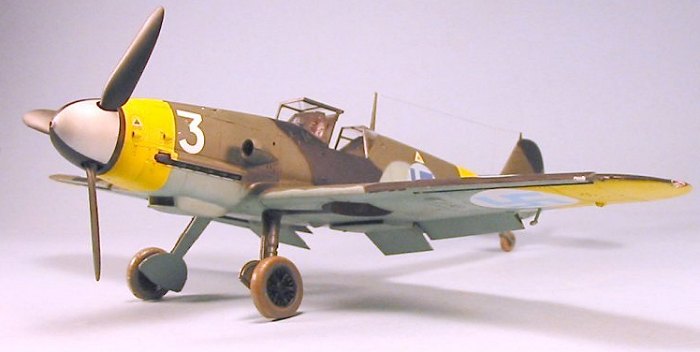
ProModeler 1/32 Bf-109G-2
|
KIT # |
? |
|
PRICE: |
$39.95 MSRP |
|
DECALS: |
Two options |
|
REVIEWER: |
Tom Cleaver |
|
NOTES: |
Aeromaster Aftermarket decals used |

|
HISTORY |
During the Winter War of 1939-40, Finland obtained 24 Brewster B-239 fighters, which were the first completely-modern fighters to equip the air force. These were U.S. Navy F2A-1s, and became the first-line fighter after the end of the war in March 1940. Finland joined with Germany in attacking the Soviet Union on June 22, 1941, in what the Finns called The Continuation War and saw as an attempt to regain the territory that had been sacrificed in the peace treaty that concluded the Winter War.
The Red Air Force in the northern regions where the Finns operated was primarily equipped with I-152 and I-153 biplane fighters and I-16 monoplanes. The Soviets would operate the I-153 and I-16 in front line fighter roles in this region as late as the summer of 1943, though Lagg-3 and Yak-1 and Yak-7 fighters began appearing in late 1942. While almost always outnumbered, the Finnish Brewsters were technically superior to their opponents; when combined with pilots who had superior training, they maintained air superiority over their part of the front, with the B-239s eventually scoring 0ver 400 victories by the time Finland was forced to capitulate in September 1944.
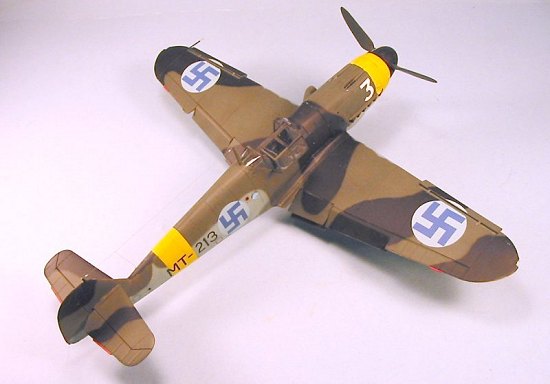 The Finns had tried as early as 1938 to
obtain first-line fighters from Germany, but had been refused. Even
after going to war as Germany’s ally, they were only able to obtain
German war booty in the form of Curtiss H-75A-3 “Hawk” fighters taken
over from France, for which they had to pay a”market” price! In
December 1942, an agreement was reached to supply 30 first-line
Bf-109G-2 fighters to equip one fighter wing, with the Germans agreeing
to supply replacements for losses. The agreement was signed February
1, 1943. The aircraft were supplied in two batches, 14 brand-new
Bf-109G-2s that arrived March 13 and 16 completely-overhauled
ex-Luftwaffe G-2s that arrived on May 10.
The Finns had tried as early as 1938 to
obtain first-line fighters from Germany, but had been refused. Even
after going to war as Germany’s ally, they were only able to obtain
German war booty in the form of Curtiss H-75A-3 “Hawk” fighters taken
over from France, for which they had to pay a”market” price! In
December 1942, an agreement was reached to supply 30 first-line
Bf-109G-2 fighters to equip one fighter wing, with the Germans agreeing
to supply replacements for losses. The agreement was signed February
1, 1943. The aircraft were supplied in two batches, 14 brand-new
Bf-109G-2s that arrived March 13 and 16 completely-overhauled
ex-Luftwaffe G-2s that arrived on May 10.
Lentolaivue (LeLv) 34 was formed as a new fighter regiment to operate the Bf-109G-2s. Most personnel came from LeLv 24, the premier Finnish fighter unit equipped with B-239s and including many of the leading aces. Pilots had gone to Germany for training in the Bf-109 prior to joining the unit. Major Olavi Ehrenrooth was the first CO, but was killed in a flying accident on March 27, 1943. Major Eino Luukanen assumed command, and would remain LeLv 34 CO until the end of the war.
The Messerschmitts first made their presence known to the Red Air Force on March 24, 1943, when Warrant Officer Ilmari Juutilanen shot down a Pe-2 over the Estonian coast. It was the first of an eventual 58 victories Juutilanen would score while flying the Bf-109, atop 36 victories scored in the Fokker D.XXI during the Winter War and with the B-239 in the Continuation War, making him the Finnish Ace of Aces with 94 victories.
The Finns generally operated their Bf-109s in flights of two or four, to intercept Soviet aircraft over the front lines and to protect Helsinki from bombing raids. There were larger battles, with the first of these coming May 20, when five Bf-109s led by Captain Olli Puhakka engaged 23 Soviet fighters, shooting down one I-16 and one Yak-1, while Lt. Paavo Myllyla with four Bf-109s intercepted 12 I-153 Chaikas and shot down two. Though the Chaika was technically outclassed by the Bf-109 in almost all categories, its pilots would give the Finnish 109 pilots difficulty throughout the period of the Chaika’s remaining service because of its agile maneuverability.
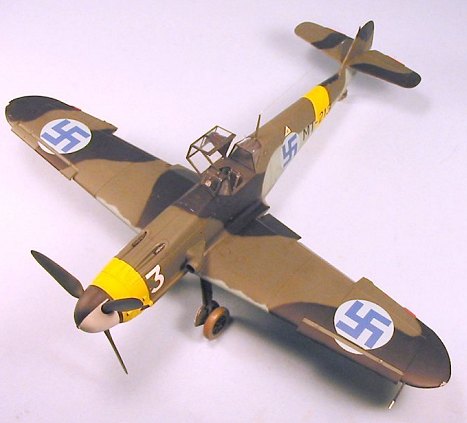 On May 21, Major Luukanen led 11 Bf-109s to
intercept four Il-2s escorted by 17 Lagg-3s and La-5s. 16 B-239s and
12 German-flown Fw-190s from JG 54 joined in the fight. Luukanen’s
force scored two Il-2s, two Lagg-3s and two La-5s before the five
Soviet survivors fled the scene of battle. Similar battles were fought
over the Karelian peninsula for the rest of 1943, with the Finns
consistently out-scoring their Soviet opponents.
On May 21, Major Luukanen led 11 Bf-109s to
intercept four Il-2s escorted by 17 Lagg-3s and La-5s. 16 B-239s and
12 German-flown Fw-190s from JG 54 joined in the fight. Luukanen’s
force scored two Il-2s, two Lagg-3s and two La-5s before the five
Soviet survivors fled the scene of battle. Similar battles were fought
over the Karelian peninsula for the rest of 1943, with the Finns
consistently out-scoring their Soviet opponents.
By early 1944, the Finns were down to thirteen operational Bf-109s, despite German replacements which had provided a total of 48 Bf-109G-2s. A new agreement was concluded on March 15, 1944, to provide another 30 Bf-109G-6 fighters, thus allowing the Finns to equip two fighter regiments with Messerschmitts. 15 of the Bf-109G-6s arrived by March 18, allowing LeLv 34 to transfer their surviving Bf-109G-2s to the B-239-equipped LeLv 24, which in turn passed their 15 surviving B-239s on to LeLv 26. The Finnish State Aircraft Factory had managed to re-build several damaged Bf-109G-2s by replacing damaged parts of one with undamaged parts of another, so that LeLv 24 had 18 Bf-109G-2s by the time the Soviet offensive began on June 9, 1944, that would finally push Finland out of the war within 90 days.
Fighting over the front during the summer of 1944 against the Soviet offensive was an almost-daily affair for both Bf-109-equipped units. For instance, on June 10, Lt. Sarjamo led 4 Bf-109G-2s of 2/HleLv 24 against 10 Pe-2s escorted by 60 Yak and Lavochkin fighters, shooting down three Pe-2s before diving away from the escorts. Later that day, Captain Jouko Myllymaki led his flight of four Bf-109G-2s against a Soviet formation of 36 Pe-2s escorted by over 40 La-5s, shooting down three Pe-2s and two La-5s, again for no losses by the Finns.
On June 19, LeLv 24 received eight new Bf-109G-6s to the third flight, while LeLv 34 received six to make good losses.
Throughout June and July, the Messerschmitts attacked Soviet formations over the front, with particularly difficult battles over Viipuri-Tali area. One particularly large engagement on June 28 saw a flight led by Captain Hans Wind of LeLv 24 lead 11 Bf-109s against 20 Il-2s and 20 Pe-2s that were attacking Finnish positions, shooting down eight Il-2s, two Pe-2s and an escorting La-5, while that afternoon Captain Puhakka of 3/HleLv 34 intercepted 60 Il-2s escorted by 40 fighters; Lt. Puro of 2/HleLv 24 arrived with 8 Bf-109G-2s and in the ensuing air battle the Soviets lost six IL-2s, two Yak-3s, two Yak-9s and one P-39 Airacobra. In all on that one day, HleLv 24 scored 33 victories while HleLv 34 scored another 10, all without loss, though a wound suffered by Captain Hans Wind put him out of action for the remainder of the war.
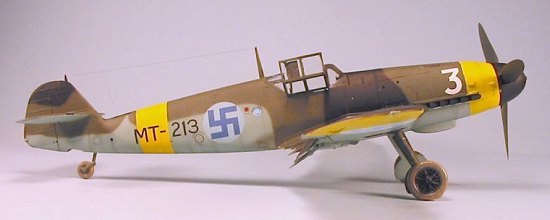 During the Soviet offensive, which lasted 38
days, The Finnish Bf-109s and B-239s claimed 425 Soviet aircraft
destroyed and another 78 damaged, while the Fw-190s of II/JG 54
led by Major Erich Rudorffer scored a further 126 victories.
During the Soviet offensive, which lasted 38
days, The Finnish Bf-109s and B-239s claimed 425 Soviet aircraft
destroyed and another 78 damaged, while the Fw-190s of II/JG 54
led by Major Erich Rudorffer scored a further 126 victories.
The last victories of the Continuation War came on August 8, 1944, when Major Luukanen’s four Bf-109G-6s intercepted six Il-2s escorted by six Yak-9s, shooting down on Il-2 and two Yak-9s. The truce was signed on September 4, 1944. Finland maintained its independence by confirming the border created by the Winter War, with additional territory ceded from northeastern Finland.
HleLv 34 scored a total of 345 victories on Bf-109s, losing 13 aircraft in air-to-air combat and five to anti-aircraft fire, with 12 pilots killed and one becoming a POW. HLeLv24 had scored 300 victories while flying the Bf-109 in the last six months of the conflict, losing 12 109s in combat and two in an air raid, with 9 pilots killed and one becoming a POW. Total Bf-109 victories - including 3 by HLeLv30 and 15 by HleLv 28 right at the end - was 663 for a total loss of 24, a victory ratio of 25-1.
Of 162 Bf-109Gs supplied during the war, the Finns had 102 available at the end. The Paris Agreement of 1947 limited them to 60 front-line fighters, with the rest put into storage and used for attrition. 41 aircraft were destroyed or damaged beyond repair in post-war service, with the last flight being made by Lt. Col. Erkki Heinila on March 13, 1944, to commemorate the 11th anniversary of the Bf-109's arrival in Finland.
MT-213 - the Career of a Fighter:
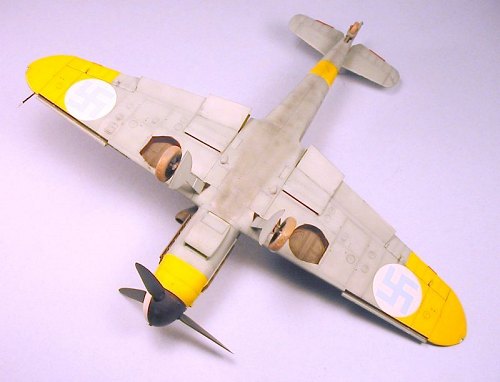 MT-213, one of the first batch of Bf-109G-2s
delivered to the Finnish Air Force, was delivered from the Messerschmitt
factory at Weiner-Neustadt, Austria, on March 9, 1943, and was flown to
Malmi, Finland, on March 16, 1943. The aircraft was assigned to 3/HleLv
34, to be flown by Lt. Reino Valli. On landing at Utti airfield
following combat on May 20, 1945, Lt. Valli taxied into the wing of a
Luftwaffe Junkers W.34. 45 minutes later, Master Sergeant Onni
Paronen in MT-216 collided with MT-213 while taxying and smashed the rear
fuselage. MT-213 was delivered to the State Aircraft Factory on June 8,
1943 for major repairs.
MT-213, one of the first batch of Bf-109G-2s
delivered to the Finnish Air Force, was delivered from the Messerschmitt
factory at Weiner-Neustadt, Austria, on March 9, 1943, and was flown to
Malmi, Finland, on March 16, 1943. The aircraft was assigned to 3/HleLv
34, to be flown by Lt. Reino Valli. On landing at Utti airfield
following combat on May 20, 1945, Lt. Valli taxied into the wing of a
Luftwaffe Junkers W.34. 45 minutes later, Master Sergeant Onni
Paronen in MT-216 collided with MT-213 while taxying and smashed the rear
fuselage. MT-213 was delivered to the State Aircraft Factory on June 8,
1943 for major repairs.
During its time at the State Aircraft Factory, MT-213 became the only Bf-109 to be repainted in the standard Finnish Air Force camouflage scheme of green and black upper surfaces with light blue lower surfaces during the war; this pattern was applied to all surviving Bf-109s as they were overhauled after the war. (Ed note: Just to belay the e-mails that will come in, the reference shows a number of other G-2s in this scheme during spring/summer 1944 time frame, including MT-221, MT-230 and MT-232 as well as MT-213)
MT-213 returned to service with 1/LeLv 34 on January 3, 1944. During a training flight on February 27, 1944, Master Sergeant Nils Katajainen experienced engine failure and crash landed at Suulajaarvi airfield. During repair at the field air depot, the darker national markings were applied.
Following repairs, the aircraft was delivered two 2/HleLv 24, and assigned to Lt. Eero Riihikallio, who scored three victories while flying MT-213 before it was sent on to 2/HleLv 28, based north of Lake Ladoga, where it was assigned to Lt. Vaaino Vuori. On July 18, 1944, Lt. Esko Haalfors stalled on takeoff at Utti airfield. MT-213 was damaged beyond repair and was stricken off charge on August 30 with a total 158 flying hours logged in Finnish service.
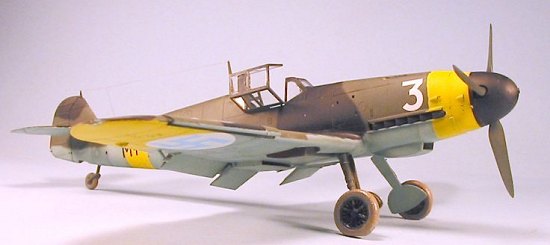 MT-213 was successful in air combat. On May 5,
1943, Sergeant Nuorala shot down an La-5. On May 16, Master Sergeant
Lehtovaara shot down two Lagg-3s. Sergeant Alakoski shot down one I-153
on May 16 and another on May 17. Following assignment to HleLv 24,
Sergeant Peltola shot down an La-5 on June 2, 1944 while Lt. Lumme shot
down a Pe-2 on June 10. Regular pilot Riikikallio got an La-5 on June
17, and two La-5s on June 23. On the same day St. Halonen shot down an
La-5. MT-213s last combat victory came when Lt. Nyman shot down an La-5
on July 6,1944, before the Messerschmitt was sent on to HleLv 28 at the
end of the week. (Where it was damaged beyond repair in a training
accident on 18 July, 1944. Ed)
MT-213 was successful in air combat. On May 5,
1943, Sergeant Nuorala shot down an La-5. On May 16, Master Sergeant
Lehtovaara shot down two Lagg-3s. Sergeant Alakoski shot down one I-153
on May 16 and another on May 17. Following assignment to HleLv 24,
Sergeant Peltola shot down an La-5 on June 2, 1944 while Lt. Lumme shot
down a Pe-2 on June 10. Regular pilot Riikikallio got an La-5 on June
17, and two La-5s on June 23. On the same day St. Halonen shot down an
La-5. MT-213s last combat victory came when Lt. Nyman shot down an La-5
on July 6,1944, before the Messerschmitt was sent on to HleLv 28 at the
end of the week. (Where it was damaged beyond repair in a training
accident on 18 July, 1944. Ed)
MT-213's combat logbook is typical of a Second World War fighter aircraft, in that her “regular” pilot flew her only occasionally, while she was the victim of ham-handedness on the part of her pilots and others on three occasions, before being written off in an operational accident.
|
THE KIT |
Hasegawa brought out their first new 1/32 scale model in 2002, with release of the Messerschmitt Bf-109G-6. The was accurate in outline and provided sufficient detail that a modeler could create a good model with what was in the box, while those wishing more detail could get resin cockpits and other aftermarket items like decals. At $36 retail, it represents good value. The kit was designed to allow different versions to be made from the basic design; to date, the Bf-109G-14 and Bf-109K-4 have been released, with the Bf-109G-10 set to arrive this coming May.
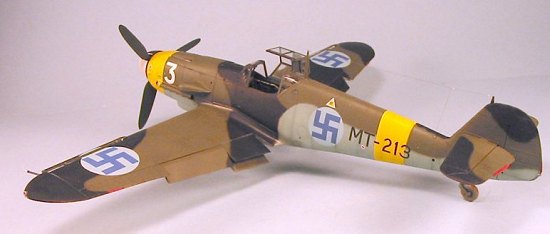 As part of their production agreement with
Revell-Monogram, Hasegawa provided a Bf-109G-4 kit which was released
last year by Pro-Modeler. This kit has a different upper cowling part to
cater to the 7.7mm machine guns carried by the type, and resin wheels of
the earlier, narrower type used by the G-4. Otherwise the kit is the
same Bf-109G-6 kit, which means a modeler needs to be aware of which
small things - such as the plate for the Morane antenna in the lower
wing, and the filler points on the fuselage right side - are not used on
the earlier Gustav. It is apparent from the fact that the upper cowling
parts come on a sprue labeled “Bf-109F” and that the wheel wells are
molded round in the manner of the Bf-109F, that we will soon see the
Friedrich released.
As part of their production agreement with
Revell-Monogram, Hasegawa provided a Bf-109G-4 kit which was released
last year by Pro-Modeler. This kit has a different upper cowling part to
cater to the 7.7mm machine guns carried by the type, and resin wheels of
the earlier, narrower type used by the G-4. Otherwise the kit is the
same Bf-109G-6 kit, which means a modeler needs to be aware of which
small things - such as the plate for the Morane antenna in the lower
wing, and the filler points on the fuselage right side - are not used on
the earlier Gustav. It is apparent from the fact that the upper cowling
parts come on a sprue labeled “Bf-109F” and that the wheel wells are
molded round in the manner of the Bf-109F, that we will soon see the
Friedrich released.
Converting the G-4 to a G-2.
The major physical difference between the Bf-109G-4 and the earlier Bf-109G-2 is the retractable tail wheel of the G-2. This requires a modeler open up the covered-over tail wheel well, and find a substitute gear leg and wheel. As someone who primarily builds in 1/48, this stumped me for a moment, before I remembered having an extra tail wheel for a Tamiya Beaufighter. While it may not be exactly right for a Bf-109, the wheel is the right size, and when it is attached in position it looks right.
|
CONSTRUCTION |
The kit comes with a separate tail. While the instructions say to assemble the tail and attach it to the fuselage after the fuselage is assembled, I found on my first kit that this resulted in a poor fit along the panel line, which meant I had to sand down the area to get the two sections to fit well, then polish it over. By attaching the tail half to the relevant fuselage half before further assembly, the modeler can get the parts aligned right to begin with, not to mention one can glue in the tail to the inner attachment points of the fuselage and get a much more solid joint. Once that had set up, and I had ground off the molded-in cockpit detail in the fuselage halves, I assembled the fuselage, including the upper cowling panel, but leaving off the oil cooler so that I could have room to maneuver the cockpit when I attached it in position.
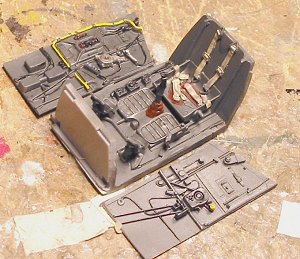 While the kit cockpit is detailed enough to be
acceptable, 1/32 scale asks for greater detail just by its size.
Fortunately there are several aftermarket 1/32 cockpits available. For
those Serious 109 Nuts, the cockpits by Monsieur 109 Nut
Vincent for MDC are the best, since they have the different variations
inside the cockpit for the early Gustav, mid-production G-6, later
production G-14, and the K-4. Personally - being neither a Serious
109 Nut or a Cockpit Detail Experte - I found the Cutting Edge
cockpit for the Bf-109G-6 more than acceptable for my project. (Yes, I
agree with everyone that you do need a different cockpit for the K-4,
even if I did use a Cutting Edge cockpit and substitute the kit part for
the right side, which is where the major difference lies.) While I have
been enjoying the use of the Cutting Edge posable resin seatbelts, I
chose to use the cockpit version that provides the molded-in seatbelts
for this project. I also substituted the kit instrument panel with
decals over the resin version. After painting and detailing the cockpit,
I assembled it and attached it in position in the fuselage.
While the kit cockpit is detailed enough to be
acceptable, 1/32 scale asks for greater detail just by its size.
Fortunately there are several aftermarket 1/32 cockpits available. For
those Serious 109 Nuts, the cockpits by Monsieur 109 Nut
Vincent for MDC are the best, since they have the different variations
inside the cockpit for the early Gustav, mid-production G-6, later
production G-14, and the K-4. Personally - being neither a Serious
109 Nut or a Cockpit Detail Experte - I found the Cutting Edge
cockpit for the Bf-109G-6 more than acceptable for my project. (Yes, I
agree with everyone that you do need a different cockpit for the K-4,
even if I did use a Cutting Edge cockpit and substitute the kit part for
the right side, which is where the major difference lies.) While I have
been enjoying the use of the Cutting Edge posable resin seatbelts, I
chose to use the cockpit version that provides the molded-in seatbelts
for this project. I also substituted the kit instrument panel with
decals over the resin version. After painting and detailing the cockpit,
I assembled it and attached it in position in the fuselage.
At this point, there is a problem with the use
of a resin cockpit, unless the modeler has taken the time to grind down
the floor so it is as thin as the original kit part. I didn’t do this,
and thus had to cut down the center section of the wing spar part
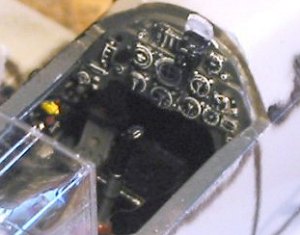 so that
it would fit inside the fuselage below the cockpit. This didn’t make the
spars any less strong, and saved a considerable bit of time - not to
mention avoiding the resin dust! - that would have been spent grinding
down the resin part. Once the cockpit was in position and the spars had
been modified, I attached the lower fuselage cover and the oil cooler and
attached the horizontal stabilizers. I then set the fuselage assembly
aside and turned to the wings.
so that
it would fit inside the fuselage below the cockpit. This didn’t make the
spars any less strong, and saved a considerable bit of time - not to
mention avoiding the resin dust! - that would have been spent grinding
down the resin part. Once the cockpit was in position and the spars had
been modified, I attached the lower fuselage cover and the oil cooler and
attached the horizontal stabilizers. I then set the fuselage assembly
aside and turned to the wings.
Early Bf-109G-2s had a wheel well like that of most Bf-109Fs. However, most had the squared-off outer end, which means one needs to trim the wheel well out before further assembly.
I painted and glued in the radiator assemblies, then glued the wing together and set it aside. This was repeated for the other one.
Once these sub-assemblies had all set up, I glued the wings to the fuselage. I attached the Cutting Edge early Revi gunsight, then glued the windscreen and the rear canopy in position.
|
COLORS & MARKINGS |
Painting:
Fortunately, I had the old Aeromaster Finnish Fighters decal sheet instructions, which has a painting diagram for MT-213 that shows both left and right sides as well as upper and lower views. This is important, because the left and right sides are differently painted along the demarcation line between upper and lower camouflage.
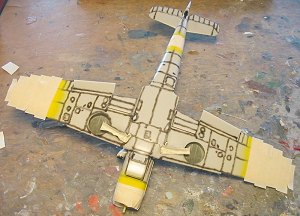 First I pre-shaded the model along panel lines
with black, then painted the yellow theater markings on the nose, rear
fuselage and lower wing tips, then masked them off. I used Gunze-Sangyo
“RAF Dark Green” which is very olive, for the Olive Green color, with a
few drops of Gunze-Sangyo FS34092 Medium Green added in to go over the
panels for post-shading. I used Tamiya X-18 Semi-gloss black for the
black areas. I added in a bit of grey to the black and went over the
panels with this, to give a bit of a fading effect to the color. I used
Gunze-Sangyo RLM65 “Hellblau” for the lower camouflage color. The
pattern was freehanded as it was on the original, which looks good in
1/32 scale. When all was dry I gave the model a coat of future.
First I pre-shaded the model along panel lines
with black, then painted the yellow theater markings on the nose, rear
fuselage and lower wing tips, then masked them off. I used Gunze-Sangyo
“RAF Dark Green” which is very olive, for the Olive Green color, with a
few drops of Gunze-Sangyo FS34092 Medium Green added in to go over the
panels for post-shading. I used Tamiya X-18 Semi-gloss black for the
black areas. I added in a bit of grey to the black and went over the
panels with this, to give a bit of a fading effect to the color. I used
Gunze-Sangyo RLM65 “Hellblau” for the lower camouflage color. The
pattern was freehanded as it was on the original, which looks good in
1/32 scale. When all was dry I gave the model a coat of future.
Decals:
There are no 1/32 decals for MT-213 available. However, Aeromaster has three 1/32 Bf-109 sheets, with a Finnish 109 on each. Using these I was able to get the darker national markings for the upper wings and fuselage, with lighter color markings for the lower wing, and to piece together the serial number, using a “2", “1,” and “3" from each sheet. Only a few of the technical markings were re-applied after the repaint, so I applied those I could see in photos. When the decals had set, I washed off the model to get rid of setting solution residue, and applied another coat of Future.
|
FINAL CONSTRUCTION |
Final Assembly and Finish:
Photos of the repainted airplane show it quite clean. I decided to only “ding” it in the area where the pilot would scuff the wing getting in and out, and to apply exhaust and oil stains, which were done with Tamiya “Smoke.” I then gave the model three overall coats of thinned Dullcote to get it down to “flat with a slight sheen,” which is the way most airplanes are with a flat-finish paint scheme unless it is sun-faded (and there’s not much sun to do any fading in Finland).
I then attached the landing gear, the aileron mass balances, the prop and spinner, and the canopy. I used nylon repair thread for the antenna wire.
|
CONCLUSIONS |
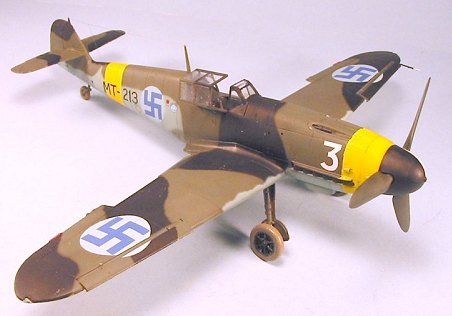 MT-213 is the most distinctively-painted of
the Finnish 109s to see service during the war. Since there are no
decals for it, I’m fairly sure there aren’t 50 of them out there just
like it.
MT-213 is the most distinctively-painted of
the Finnish 109s to see service during the war. Since there are no
decals for it, I’m fairly sure there aren’t 50 of them out there just
like it.
These 1/32 Hasegawa kits are great for the modeler who wants to do a kit with a distinctive finish. I’m definitely getting hooked on them for doing these “one-off” schemes.
Kit courtesy of my billfold.
|
REFERENCES |
Editor's Note: A really excellent reference on Finnish Bf-10G-2s is Suomen Ilmavoimien Historia Volume 6a. This book and Volume 11 on Finnish Aces provides a wealth of information regarding other pilots and aircraft of the Finnish AF.
May 2004
Copyright ModelingMadness.com
If you would like your product reviewed fairly and fairly quickly, pleasecontact the editor or see other details in the Note to Contributors.